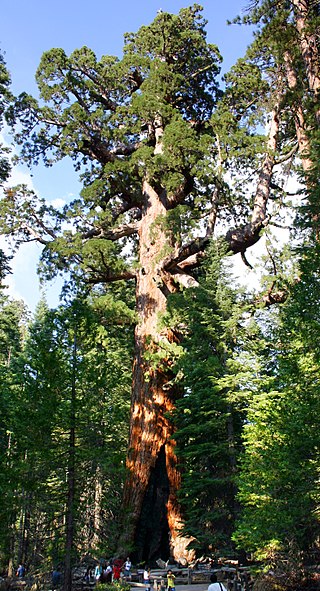
Sequoiadendron giganteum, also known as the giant sequoia, giant redwood or Sierra redwood is a coniferous tree, classified in the family Cupressaceae in the subfamily Sequoioideae. Giant sequoia specimens are the most massive trees on Earth. They are native to the groves on the western slopes of the Sierra Nevada mountain range of California but are grown around the world.
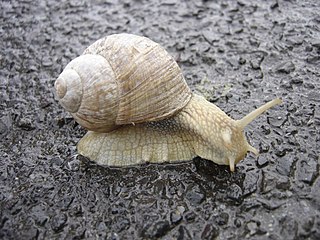
A snail is a shelled gastropod. The name is most often applied to land snails, terrestrial pulmonate gastropod molluscs. However, the common name snail is also used for most of the members of the molluscan class Gastropoda that have a coiled shell that is large enough for the animal to retract completely into. When the word "snail" is used in this most general sense, it includes not just land snails but also numerous species of sea snails and freshwater snails. Gastropods that naturally lack a shell, or have only an internal shell, are mostly called slugs, and land snails that have only a very small shell are often called semi-slugs.

Helix is a genus of large, air-breathing land snails native to the western Palaearctic and characterized by a globular shell.

George Montagu was an English army officer and naturalist. He was known for his pioneering Ornithological Dictionary of 1802, which for the first time accurately defined the status of Britain's birds. He is remembered today for species such as the Montagu's harrier, named after him.

Pinus strobus, commonly called the eastern white pine, northern white pine, white pine, Weymouth pine (British), and soft pine is a large pine native to eastern North America. It occurs from Newfoundland, Canada, west through the Great Lakes region to southeastern Manitoba and Minnesota, United States, and south along the Appalachian Mountains and upper Piedmont to northernmost Georgia and perhaps very rarely in some of the higher elevations in northeastern Alabama. It is considered rare in Indiana.

Edward Sylvester Morse was an American zoologist, archaeologist, and orientalist. He is considered the "Father of Japanese archaeology."

William Stimpson was an American scientist. He was interested particularly in marine biology. Stimpson became an important early contributor to the work of the Smithsonian Institution and later, director of the Chicago Academy of Sciences.

Cornu aspersum, known by the common name garden snail, is a species of land snail in the family Helicidae, which includes some of the most familiar land snails. Of all terrestrial molluscs, this species may well be the most widely known. It was classified under the name Helix aspersa for over two centuries, but the prevailing classification now places it in the genus Cornu.

Helix pomatia, common names are the Roman snail, Burgundy snail, or escargot, is a species of large, air-breathing stylommatophoran land snail native to Europe. It is characterized by a globular brown shell. It is an edible species. Helix pomatia commonly occurs synanthropically throughout its range.

The Scotch bonnet is a medium-sized to large species of sea snail, a marine gastropod mollusk in the subfamily Cassinae, the helmet shells and bonnet shells. The common name "Scotch bonnet" alludes to the general outline and color pattern of the shell, which vaguely resemble a tam o' shanter, a traditional Scottish bonnet or cap. The shell is egg-shaped and fairly large, 2 to 4 inches in maximum dimension, with a regular pattern of yellow, orange or brown squarish spots. The surface sculpture of the shell is highly variable: the surface can be smooth and polished, have grooves, be granulated, or even be nodulose on the shoulder of the whorls.
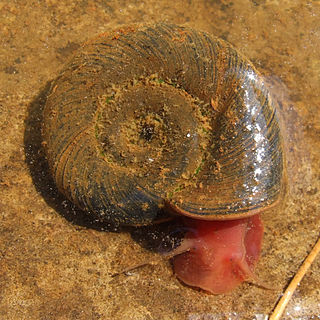
Planorbarius corneus, common name the great ramshorn, is a relatively large species of air-breathing freshwater snail, an aquatic pulmonate gastropod mollusk in the family Planorbidae, the ram's horn snails, or planorbids, which all have sinistral or left-coiling shells.

Helix lucorum is a species of large, edible, air-breathing land snail, a terrestrial pulmonate gastropod mollusk in the family Helicidae, the typical snails.

Lucilla singleyana is a species of minute air-breathing land snail, a terrestrial pulmonate gastropod mollusc or micromollusk in the family Helicodiscidae.

A land snail is any of the numerous species of snail that live on land, as opposed to the sea snails and freshwater snails. Land snail is the common name for terrestrial gastropod mollusks that have shells. However, it is not always easy to say which species are terrestrial, because some are more or less amphibious between land and fresh water, and others are relatively amphibious between land and salt water.
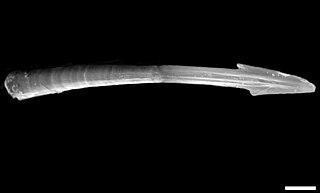
A love dart is a sharp, calcareous or chitinous dart which some hermaphroditic land snails and slugs create. Love darts are both formed and stored internally in a dart sac. These darts are made in sexually mature animals only, and are used as part of the sequence of events during courtship, before actual mating takes place. Darts are quite large compared to the size of the animal: in the case of the semi-slug genus Parmarion, the length of a dart can be up to one fifth that of the semi-slug's foot.

William Theobald was a malacologist and naturalist on the staff of the Geological Survey of India serving in Burma, then a part of British India.
Helix goderdziana is a species of large air-breathing land snail, a terrestrial pulmonate gastropod mollusk in the family Helicidae, the typical snail.

Nitor medioximus is a species of small air-breathing land snail and terrestrial pulmonate gastropod mollusk in the family Helicarionidae. This species is endemic to Australia and grows to about 12 mm in diameter.
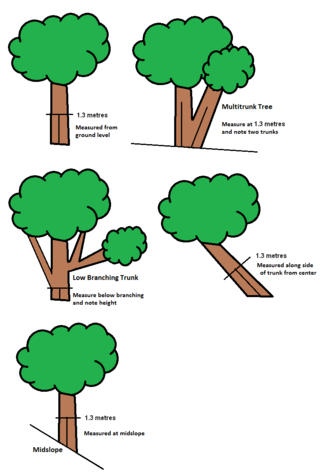
Tree girth is a measurement of the circumference of tree trunk. It is one of the most ancient, quickest, and simplest of foresters' measures of size and records of growth of living and standing trees. The methods and equipment have been standardized differently in different countries. A popular use of this measurement is to compare outstanding individual trees from different locations or of different species.
Trees have a wide variety of sizes and shapes and growth habits. Specimens may grow as individual trunks, multitrunk masses, coppices, clonal colonies, or even more exotic tree complexes. Most champion tree programs focus finding and measuring the largest single-trunk example of each species. There are three basic parameters commonly measured to characterize the size of a single trunk tree: tree height measurement, tree girth measurement, and tree crown measurement. Foresters also perform tree volume measurements. A detailed guideline to these basic measurements is provided in The Tree Measuring Guidelines of the Eastern Native Tree Society by Will Blozan.



















